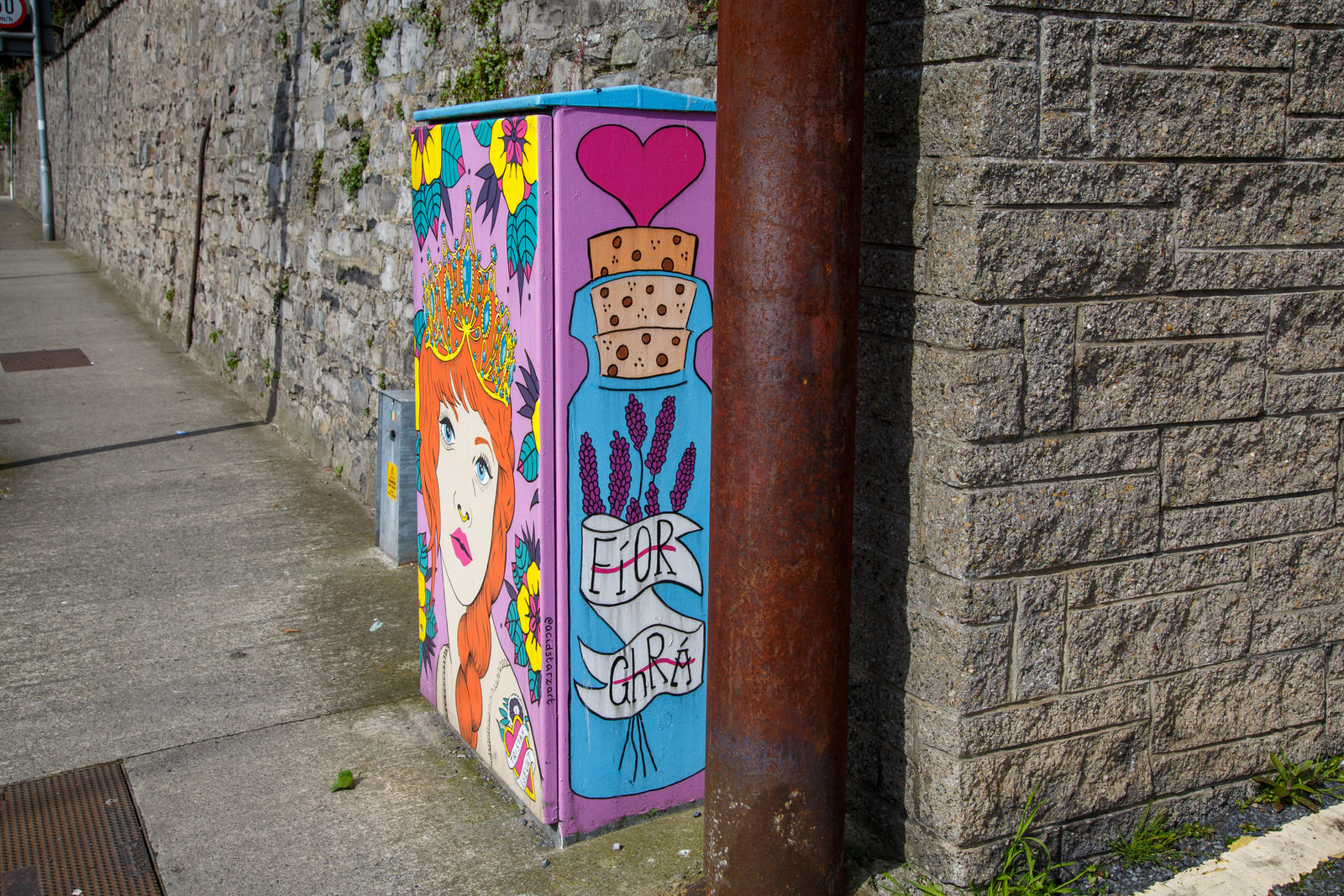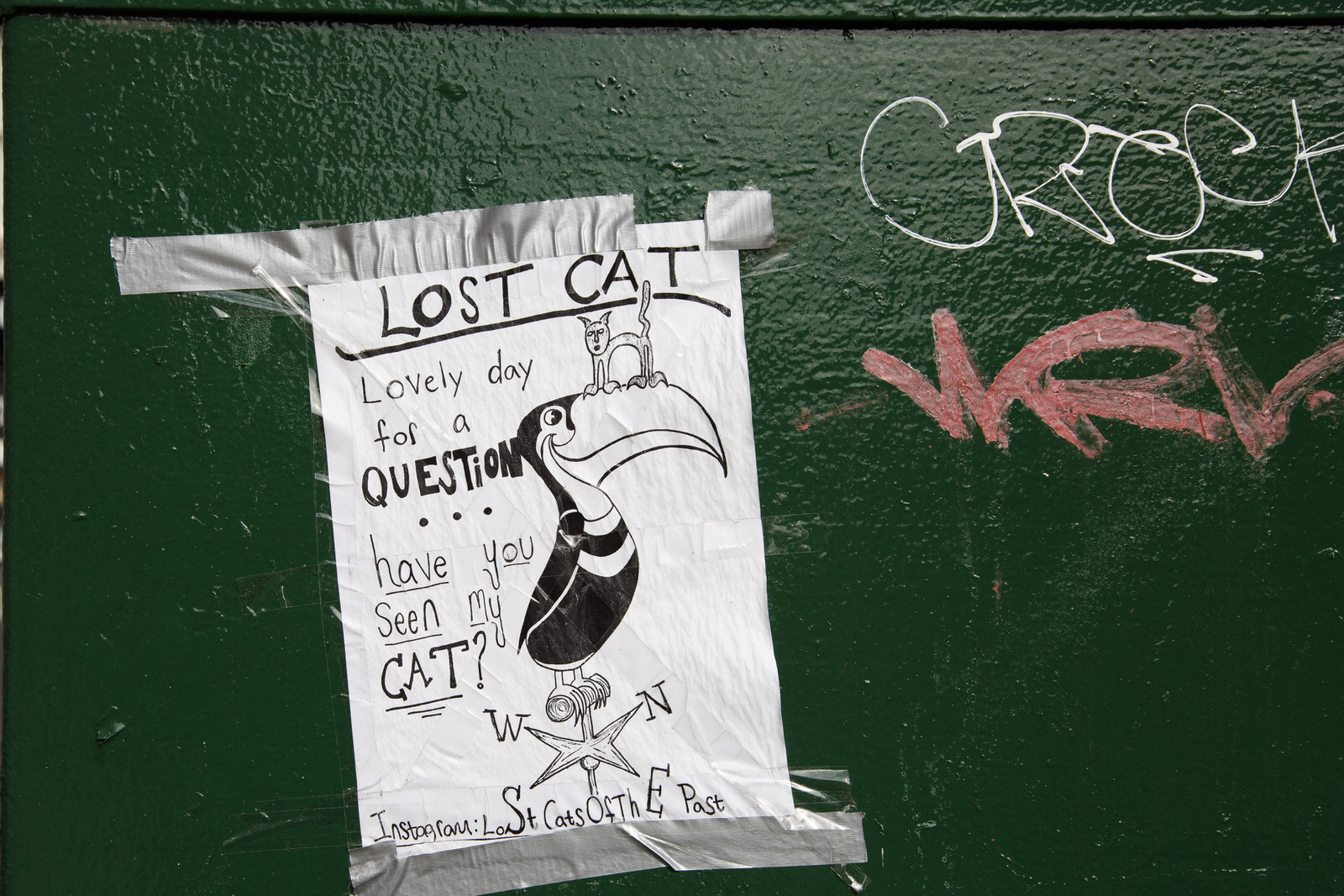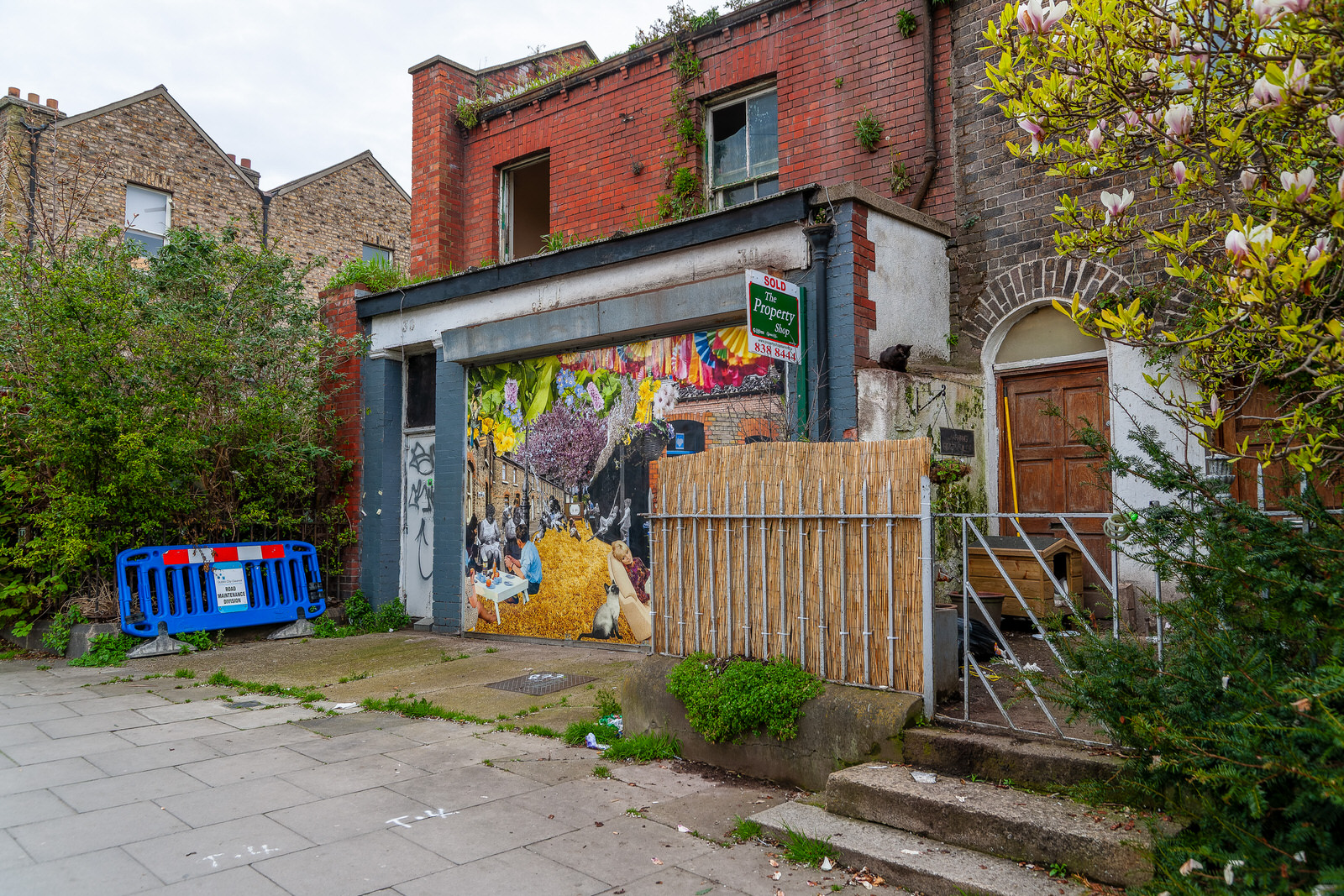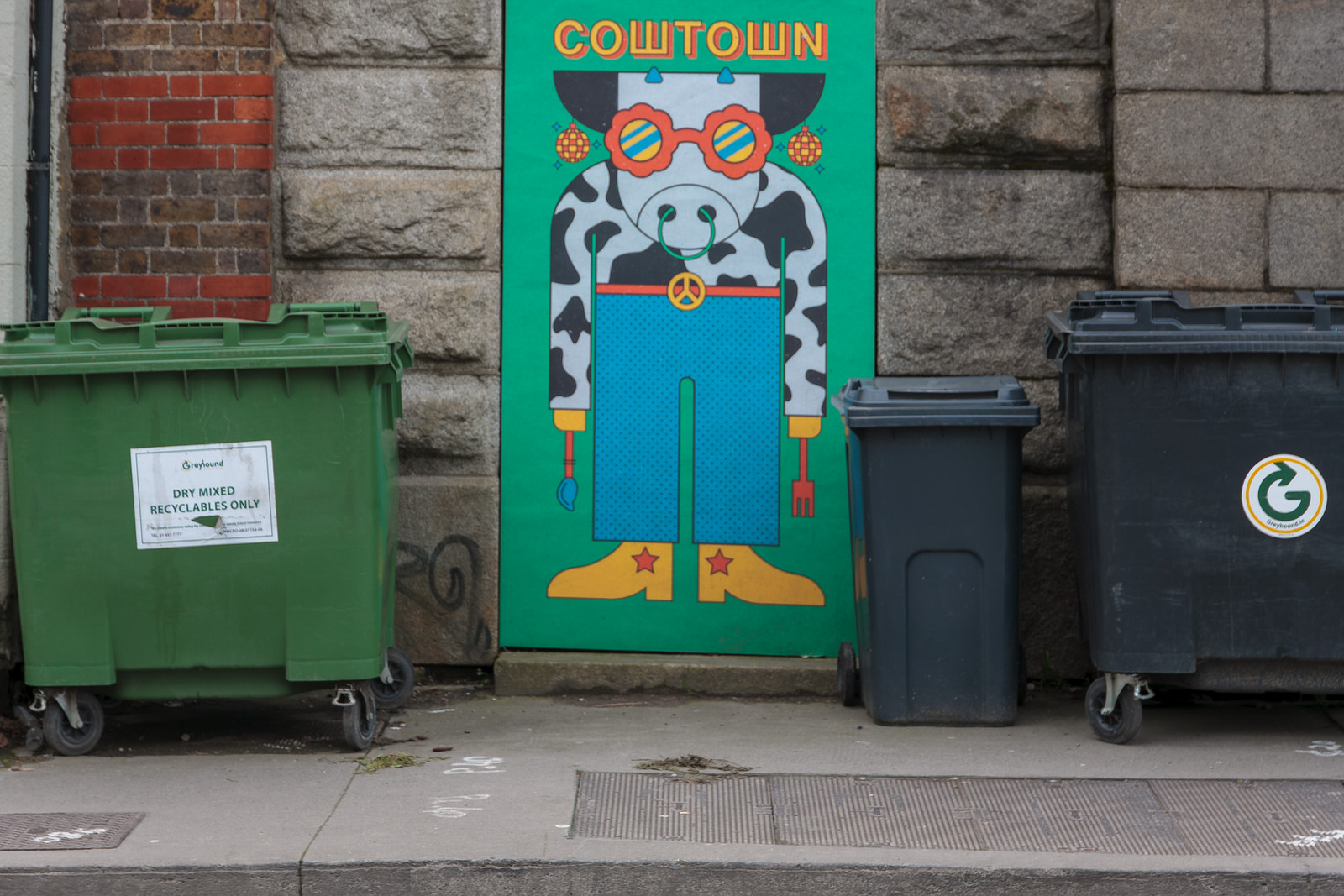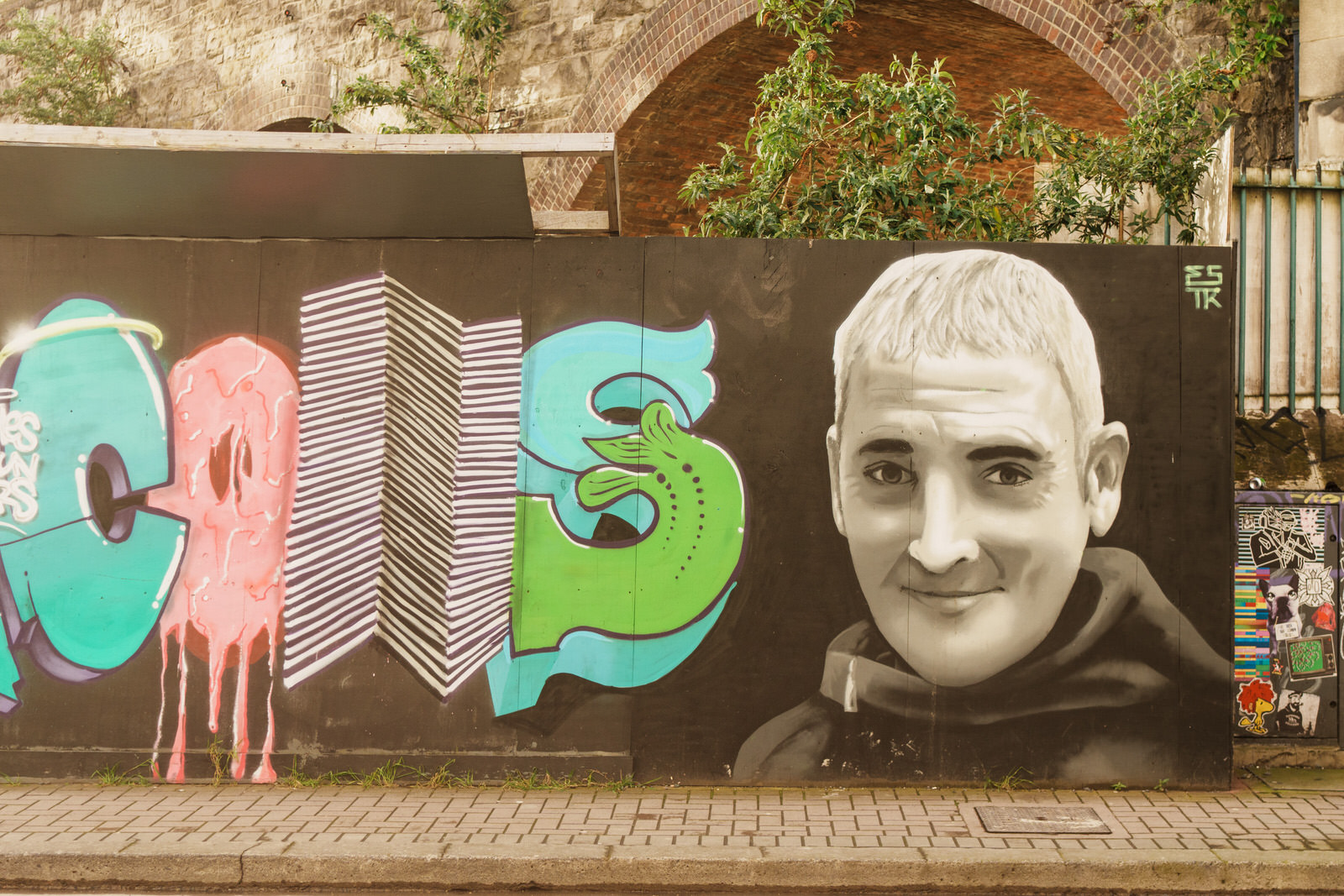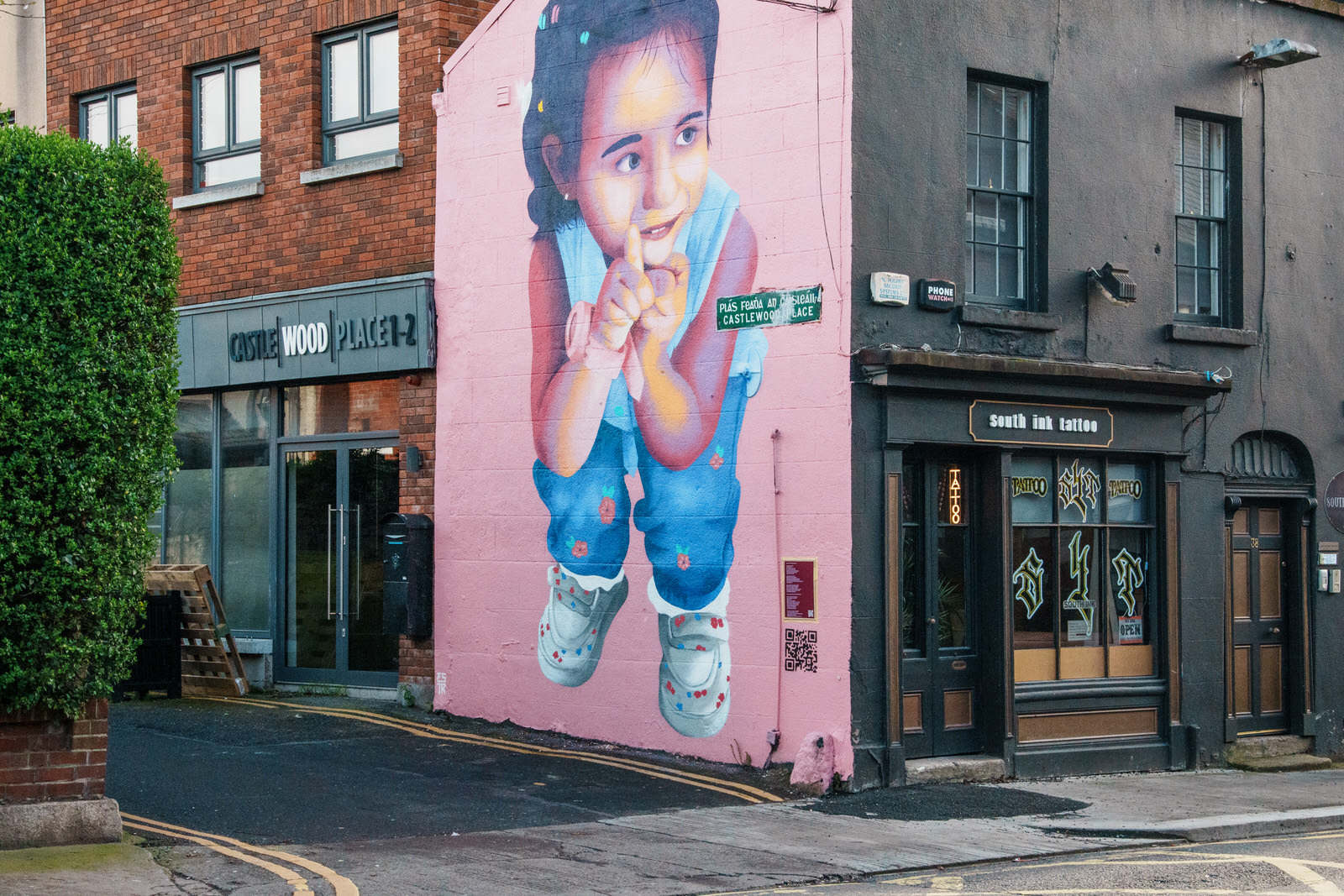PAINT-A-BOX STREET ART BY ACIDSTARZART FROM BELFAST [TWO EXAMPLES IN CHAPELIZOD]
Belfast-Based Artist: AcidStarzArt is a street artist primarily operating out of Belfast, Northern Ireland.
Unique Style: Their work is characterised by a bold, graphic style with strong lines and vibrant, often neon colours. They frequently combine figurative and abstract elements.
Recurring Themes: AcidStarzArt explores themes such as mythology, folklore, pop culture, and social commentary. They often feature strong female figures and iconic characters with playfully subversive twists.
Notable Works and Projects:
Dublin Canvas: AcidStarzArt has participated in the Dublin Canvas art project, creating several of the "Paint-a-Box" murals around the city. Their piece "Macha" depicts the Irish goddess of the same name and explores themes of feminine power and Irish mythology.
Hit the North Street Art Festival: A frequent contributor to this Belfast festival, expanding their impact on the city's vibrant street art scene.
Collaborations: AcidStarzArt has worked with other street artists and has even collaborated with commercial brands in interesting ways.
Where to Find AcidStarzArt
Instagram: Their Instagram (https://www.instagram.com/acidstarzart/) is the best place to see their newest work and get updates on projects.
Street Art Websites: Websites dedicated to street art often feature AcidStarzArt's murals and installations.
Belfast: If you're in Belfast, keep your eyes open! You might stumble upon some of their amazing street art in unexpected places.
Belfast-Based Artist: AcidStarzArt is a street artist primarily operating out of Belfast, Northern Ireland.
Unique Style: Their work is characterised by a bold, graphic style with strong lines and vibrant, often neon colours. They frequently combine figurative and abstract elements.
Recurring Themes: AcidStarzArt explores themes such as mythology, folklore, pop culture, and social commentary. They often feature strong female figures and iconic characters with playfully subversive twists.
Notable Works and Projects:
Dublin Canvas: AcidStarzArt has participated in the Dublin Canvas art project, creating several of the "Paint-a-Box" murals around the city. Their piece "Macha" depicts the Irish goddess of the same name and explores themes of feminine power and Irish mythology.
Hit the North Street Art Festival: A frequent contributor to this Belfast festival, expanding their impact on the city's vibrant street art scene.
Collaborations: AcidStarzArt has worked with other street artists and has even collaborated with commercial brands in interesting ways.
Where to Find AcidStarzArt
Instagram: Their Instagram (https://www.instagram.com/acidstarzart/) is the best place to see their newest work and get updates on projects.
Street Art Websites: Websites dedicated to street art often feature AcidStarzArt's murals and installations.
Belfast: If you're in Belfast, keep your eyes open! You might stumble upon some of their amazing street art in unexpected places.
Asbestos: From 'Lost' Posters to Urban Iconography
Asbestos, the Dublin-based street artist, has captured the city's imagination and beyond for nearly two decades. His journey reveals a fascinating evolution, a deepening exploration of themes like identity, memory, and the social fabric of urban life.
Early Days and the Power of the "Lost"
Asbestos first emerged in the early 2000s with his iconic "Lost" poster and sticker series. These stark, text-based designs featured descriptions of seemingly mundane lost objects: a single key, a glove, a crumpled photograph. They were deliberately enigmatic, inviting passersby to consider the stories behind these lost fragments and the hidden narratives that exist within our everyday surroundings.
Beyond their visual impact, the "Lost" series created a sense of participation. People who found a poster or sticker often reached out to the artist, becoming collaborators in a city-wide performance. This interactive element highlighted Asbestos's ability to transform the urban environment into a shared creative space.
Evolving Themes: Identity and Social Commentary
Asbestos's work gradually broadened to include mixed-media portraiture. Often featuring masked figures, these portraits explored the concept of identity – the masks symbolising both concealment and an exploration of multiple selves. The artist's personal narrative is also intertwined here, referencing the car bomb that went off near his mother before his birth. The portraits became reflections on chance, survival, and the fragility of existence.
In recent years, Asbestos has embraced larger-scale murals. These pieces often address social and political issues with a potent visual language. His iconic "What is Home?" mural in Cork, Ireland directly challenged the country's housing crisis, demonstrating his use of street art as a tool for social commentary.
The "Lost" Series: Transformation and Legacy
While the "Lost" series remains foundational to Asbestos's legacy, it has undergone a metamorphosis. The artist has begun incorporating found objects into his installations, adding a tangible layer to the concept of loss and discovery. He also now sometimes reveals the "finders" of the original lost items within his artwork, turning the ephemeral interactions of the early days into lasting narratives woven into the city's visual history.
A Pioneering Force
Asbestos's journey has been marked by a restless experimentation and a commitment to engaging with vital social issues. He has helped legitimise street art as a powerful medium for introspection and social critique. While his identity remains shrouded in the mystique so essential to the street art ethos, his work speaks volumes, challenging and inspiring viewers in equal measure.
Asbestos, the Dublin-based street artist, has captured the city's imagination and beyond for nearly two decades. His journey reveals a fascinating evolution, a deepening exploration of themes like identity, memory, and the social fabric of urban life.
Early Days and the Power of the "Lost"
Asbestos first emerged in the early 2000s with his iconic "Lost" poster and sticker series. These stark, text-based designs featured descriptions of seemingly mundane lost objects: a single key, a glove, a crumpled photograph. They were deliberately enigmatic, inviting passersby to consider the stories behind these lost fragments and the hidden narratives that exist within our everyday surroundings.
Beyond their visual impact, the "Lost" series created a sense of participation. People who found a poster or sticker often reached out to the artist, becoming collaborators in a city-wide performance. This interactive element highlighted Asbestos's ability to transform the urban environment into a shared creative space.
Evolving Themes: Identity and Social Commentary
Asbestos's work gradually broadened to include mixed-media portraiture. Often featuring masked figures, these portraits explored the concept of identity – the masks symbolising both concealment and an exploration of multiple selves. The artist's personal narrative is also intertwined here, referencing the car bomb that went off near his mother before his birth. The portraits became reflections on chance, survival, and the fragility of existence.
In recent years, Asbestos has embraced larger-scale murals. These pieces often address social and political issues with a potent visual language. His iconic "What is Home?" mural in Cork, Ireland directly challenged the country's housing crisis, demonstrating his use of street art as a tool for social commentary.
The "Lost" Series: Transformation and Legacy
While the "Lost" series remains foundational to Asbestos's legacy, it has undergone a metamorphosis. The artist has begun incorporating found objects into his installations, adding a tangible layer to the concept of loss and discovery. He also now sometimes reveals the "finders" of the original lost items within his artwork, turning the ephemeral interactions of the early days into lasting narratives woven into the city's visual history.
A Pioneering Force
Asbestos's journey has been marked by a restless experimentation and a commitment to engaging with vital social issues. He has helped legitimise street art as a powerful medium for introspection and social critique. While his identity remains shrouded in the mystique so essential to the street art ethos, his work speaks volumes, challenging and inspiring viewers in equal measure.
DEFACED ARTWORK AND MURAL AT 30 MANOR STREET [LOCALLY KNOWN AS THE PIGEON HOUSE]
The ‘Pigeon House’ of Stoneybatter: A Story of Decay, Art, and Controversy at 30 Manor Street”
Once a bustling residence and business on Manor Street, the building at No. 30 has now fallen into a state of disrepair, earning it the unfortunate moniker of ‘The Pigeon House.’ This dilapidated property has been a magnet for pigeons for years, causing a continuous nuisance for the locals of Stoneybatter.
Despite vibrant attempts at revitalisation through street art, both the building and its artwork have suffered from neglect and vandalism.
30 Manor Street has a rich history dating back to 1862 when it was the residence of James Campbell Moore, a clerk at the Landed Estates Court. However, the property has been plagued by a persistent pigeon problem since October 2020, when local media reported on a resident facing legal action for attracting an infestation of feral pigeons. The birds took up residence at 30 Manor Street, their droppings soiling sidewalks and nearby homes.
The property, which is currently for sale, was previously designed as a residential unit above a retail space. It requires complete refurbishment and boasts a large rear garden with potential for development. Despite its potential, the building has remained neglected since its sale in 2018.
Stoneybatter is home to an ongoing street art project, with murals appearing throughout the neighbourhood. Unfortunately, two murals associated with 30 Manor Street have met differing fates. ‘The Urban Living Room,’ a vibrant mural painted by Dublin-based artist Sorcha O’Higgins in June 2021, has been defaced by graffiti. The Dublin City Council plans to restore it [they have done so]. Additionally, French artist Claire Prouvost, known for her diverse styles, has contributed to Stoneybatter’s artistic landscape with a mural next to Rea auctioneers.
The saga of 30 Manor Street raises questions about the challenges of redevelopment, the protection of street art, and the management of urban wildlife conflicts.
The ‘Pigeon House’ of Stoneybatter: A Story of Decay, Art, and Controversy at 30 Manor Street”
Once a bustling residence and business on Manor Street, the building at No. 30 has now fallen into a state of disrepair, earning it the unfortunate moniker of ‘The Pigeon House.’ This dilapidated property has been a magnet for pigeons for years, causing a continuous nuisance for the locals of Stoneybatter.
Despite vibrant attempts at revitalisation through street art, both the building and its artwork have suffered from neglect and vandalism.
30 Manor Street has a rich history dating back to 1862 when it was the residence of James Campbell Moore, a clerk at the Landed Estates Court. However, the property has been plagued by a persistent pigeon problem since October 2020, when local media reported on a resident facing legal action for attracting an infestation of feral pigeons. The birds took up residence at 30 Manor Street, their droppings soiling sidewalks and nearby homes.
The property, which is currently for sale, was previously designed as a residential unit above a retail space. It requires complete refurbishment and boasts a large rear garden with potential for development. Despite its potential, the building has remained neglected since its sale in 2018.
Stoneybatter is home to an ongoing street art project, with murals appearing throughout the neighbourhood. Unfortunately, two murals associated with 30 Manor Street have met differing fates. ‘The Urban Living Room,’ a vibrant mural painted by Dublin-based artist Sorcha O’Higgins in June 2021, has been defaced by graffiti. The Dublin City Council plans to restore it [they have done so]. Additionally, French artist Claire Prouvost, known for her diverse styles, has contributed to Stoneybatter’s artistic landscape with a mural next to Rea auctioneers.
The saga of 30 Manor Street raises questions about the challenges of redevelopment, the protection of street art, and the management of urban wildlife conflicts.
If a old Dubliner mentions Cowtown they are likely to be referring to the area around Manor Street, Manor Place, and surrounding roads in Stoneybatter on the north side of Dublin. Here's a breakdown of its history and how it got the nickname "Cowtown":
A moo-vellous bit of Dublin history: Stoneybatter's Cowtown
Stoneybatter, a vibrant neighborhood on Dublin's northside, has a fascinating past as a centre for the cattle trade. Nicknamed "Cowtown" due to the presence of a massive cattle market in the mid-19th century, the area bustled with activity and became intrinsically linked to its bovine business.
The Rise of Cowtown
Dublin Cattle Market: Established in the mid-1800s near Prussia Street (now the Grangegorman TU Dublin campus), the Dublin Cattle Market was a major economic driver. At its peak, it was one of the largest cattle markets in Europe.
A Hub for the Cattle Trade: Farmers, herders, dealers, and associated businesses flocked to Stoneybatter to be close to the market. This influx created a unique community centred around the cattle trade.
The Name "Cowtown": The nickname likely arose from the constant presence of cattle on the streets. While some suggest it might have had a slightly derogatory connotation in the past, the name seems to have been adopted with pride by residents, reflecting their community's identity.
Cowtown's Legacy
Market Decline: The cattle market's importance gradually diminished in the early 20th century due to the rise of railways and smaller regional markets. It eventually closed in the 1970s.
Transformation and Reminders: Stoneybatter has undergone significant change and gentrification, but reminders of its Cowtown past remain:
Informative plaques mark the former location of the cattle market.
Street Art: The mural I have shared (with the cow, sunglasses, and cowboy hat) adds a playful touch, referencing the area's history.
A moo-vellous bit of Dublin history: Stoneybatter's Cowtown
Stoneybatter, a vibrant neighborhood on Dublin's northside, has a fascinating past as a centre for the cattle trade. Nicknamed "Cowtown" due to the presence of a massive cattle market in the mid-19th century, the area bustled with activity and became intrinsically linked to its bovine business.
The Rise of Cowtown
Dublin Cattle Market: Established in the mid-1800s near Prussia Street (now the Grangegorman TU Dublin campus), the Dublin Cattle Market was a major economic driver. At its peak, it was one of the largest cattle markets in Europe.
A Hub for the Cattle Trade: Farmers, herders, dealers, and associated businesses flocked to Stoneybatter to be close to the market. This influx created a unique community centred around the cattle trade.
The Name "Cowtown": The nickname likely arose from the constant presence of cattle on the streets. While some suggest it might have had a slightly derogatory connotation in the past, the name seems to have been adopted with pride by residents, reflecting their community's identity.
Cowtown's Legacy
Market Decline: The cattle market's importance gradually diminished in the early 20th century due to the rise of railways and smaller regional markets. It eventually closed in the 1970s.
Transformation and Reminders: Stoneybatter has undergone significant change and gentrification, but reminders of its Cowtown past remain:
Informative plaques mark the former location of the cattle market.
Street Art: The mural I have shared (with the cow, sunglasses, and cowboy hat) adds a playful touch, referencing the area's history.
Commercial Disclosure
You will find links to buy products from Amazon, Google and other partners. If you click on these links, you’ll find that the URL includes a small extra piece of text which identifies that the click came from my websites. This text is an affiliate code, and it means that I get a small percentage of the money you spend if you choose to buy that product, or, in some cases, other products from the site soon after. These affiliate links help pay the costs of producing my websites and ensure that the content is free to you.

